-
- Le Chemin 2014 by Geoff Cowling
- Le Chemin 2015 by Brid Fhionnagain
- Fifty Five Years On – The Chemin de la Liberté
Le Chemin 2014
By Geoff Cowling
We were forewarned by Scott Goodall that our Chemin de la Liberté guide Paul Dubons had recce’d our usual route over the Pyrenees and found the last pass over the frontier into Catalunya blocked with snow and ice and too dangerous to attempt to cross. Nor would we be able to reach the Halifax crash site. For the second year running good ole global warming had dumped an unseasonable amount of snow on the Pyrenees to thwart our plans. We would have to climb back down from the Estagnous refuge after the third day and go by bus to Esterri d’Aneau, our final destination. This was huge disappointment for newcomers to Le Chemin, but did not dampen their spirits. Nor those of the usual ELMS Chemin crowd who turned up for the event – Bernard Holvoet, Brid Ni Fhinnagain, Edgar Aromin, Helen Duffee, Jeremy Pearcy, Ray Milford, Charles Wilson, among others.
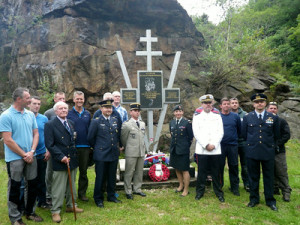
Before we set off, we were entertained by the Chemin de la Liberté Association with a reception at the informative Chemin Museum in the old St Girons Railway station and at a formal ceremony at the site of the old German command post at Kercabanac on the road to Seix.
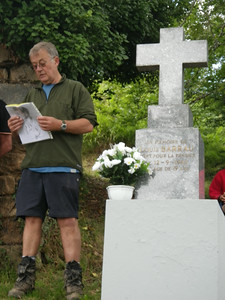 The first day was trying ten hours hard walking though the densely wooded foothills of the Pyrenees, broken by the welcome picnic lunch put on by the Barrau family in honour of Louis Barrau who was gunned down by a German patrol at a shepherds’ hut nearby, where a moving ceremony took place.
The first day was trying ten hours hard walking though the densely wooded foothills of the Pyrenees, broken by the welcome picnic lunch put on by the Barrau family in honour of Louis Barrau who was gunned down by a German patrol at a shepherds’ hut nearby, where a moving ceremony took place.
The Pyrenean village of Seix provided a night’s rest for the majority on the hard gymnasium floor. The more experienced had earlier booked into the soft beds of the neighbouring Auberge… The following is an extract from my diary which gives a flavour of the rest of the trail:-
Personally I have definitely decided to call the Chemin a day. Ten since 2003 is enough. With my left knee swelling (damaged in 2006 crossing the Creten White Mountains from the Med to the Libyan Sea) it became difficult to put pressure on it to haul myself up the face of the wretched 8,500′ Mt Valier, with the result that I fell way behind on the third 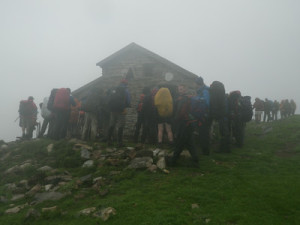 day. It was also pouring with rain, bloody cold with visibility about 50m. Moreover along with others, I had not slept well the night before where we camped just below the snow line. Temperatures dropped to around 4C. Incessant rain hammered into my tent and water “ponded” on the ground sheet by my feet. My sleeping bag soaked up the water like blotting paper and I awoke around 0300 to find myself drenched in freezing water from the waist down. I was already fully clothed in a vain attempt to keep warm. Scrambling down the cliff from the crest of Mt Valier to the refuge at Estagnous was almost as bad. I took a couple of tumbles in the snow but hurt no more than my pride. Even though I put myself straight to bed inside the refuge dorm on arrival, I was shivering for ages with hypothermia. All this in July – no wonder so many perished at other times of the year trying to escape for real.
day. It was also pouring with rain, bloody cold with visibility about 50m. Moreover along with others, I had not slept well the night before where we camped just below the snow line. Temperatures dropped to around 4C. Incessant rain hammered into my tent and water “ponded” on the ground sheet by my feet. My sleeping bag soaked up the water like blotting paper and I awoke around 0300 to find myself drenched in freezing water from the waist down. I was already fully clothed in a vain attempt to keep warm. Scrambling down the cliff from the crest of Mt Valier to the refuge at Estagnous was almost as bad. I took a couple of tumbles in the snow but hurt no more than my pride. Even though I put myself straight to bed inside the refuge dorm on arrival, I was shivering for ages with hypothermia. All this in July – no wonder so many perished at other times of the year trying to escape for real.
It’s taken me 10 Pyreneen crossings over 12 years to work out that it is not really a good idea to increase your weight by 20% and upset your balance carrying a 15kg rucksack, then rush up a cold, slippery, icy 8,500′ mountain where the oxygen level is beginning to tail off…News from my insurance company, that they are not renewing my all-risks, world-wide policy in October because I would be 70 next year, also played a part in my decision. For the second year running we again suffered the disappointment of not being able to cross the frontier at the Col de la Claoeure into Catalunya because of excessive snow and ice. However, when we finished the 5 hour walk-out down from Estagnous we were bussed via Vielha around to Esterri d’Aneu for a suburb reception with lots of food and a dancing display by Le Chemin Association members in full Pyreneen costume – you could not buy such an experience. Unfortunately the arrangements made with the Catalan Government and the local Mayors of Esterri and Sort for 100 local walkers to meet us for a ceremony at the 8500′ frontier Col de la Claoeure fell through because of the foul weather, and sadly none turned up at the reception. On the other hand, several big plusses included the presence of George & Janet Duffee – thanks to Helen and Keith’s logistical efforts.
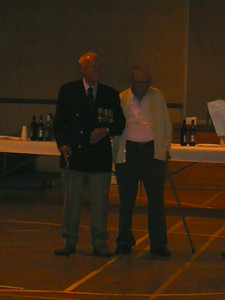 Iconic moments included WWII evader George Duffee shaking hands in Esterri with WWII passeur Paul Broué (both now 91), and George surrounded by a RAF group who coincidentally came from George’s WWII 78 RAF squadron…….. And none of this could have been done without the incredible organisational and logistical efforts of Scott and Judy Goodall in L’Escure.. Good luck for the 2015 Chemin de la Liberté – third time lucky I hope… Geoff Cowling
Iconic moments included WWII evader George Duffee shaking hands in Esterri with WWII passeur Paul Broué (both now 91), and George surrounded by a RAF group who coincidentally came from George’s WWII 78 RAF squadron…….. And none of this could have been done without the incredible organisational and logistical efforts of Scott and Judy Goodall in L’Escure.. Good luck for the 2015 Chemin de la Liberté – third time lucky I hope… Geoff Cowling
Le Chemin de la Liberte – 2015
By Brid Fhionnagain
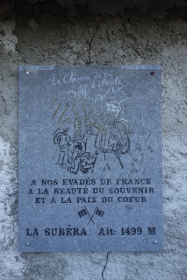 The twenty second edition of Le Chemin de la Liberté was brimming with potential, as the first opportunity to complete the traditional four-day crossing of the Pyrenees in three years was within reach. As ever, a widely ranging ensemble attended; with representatives of the Royal British Legion, NATO and MSF flanking a fine medley of repeat climbers along with eager first-timers for this memorable journey. Significant by their absence however, for the first time in the twenty two years of this commemoration, was that of international WWII veterans. Their role in events seventy years ago was prominent in our thoughts during the walk and the ceremonies throughout. The presence of their French comrade, Paul Broué, offered a poignant reminder of the strength, integrity and sacrifices made. The succeeding generations were well represented, with a significant number of father/son and father/daughter ensembles, including Paul Broué’s grandson, and ages ranging from a young French lady in her teens to a septuagenarian Englishman completing the group. More than two dozen ladies of various nations also attended, keeping step with the gentlemen in their midst.
The twenty second edition of Le Chemin de la Liberté was brimming with potential, as the first opportunity to complete the traditional four-day crossing of the Pyrenees in three years was within reach. As ever, a widely ranging ensemble attended; with representatives of the Royal British Legion, NATO and MSF flanking a fine medley of repeat climbers along with eager first-timers for this memorable journey. Significant by their absence however, for the first time in the twenty two years of this commemoration, was that of international WWII veterans. Their role in events seventy years ago was prominent in our thoughts during the walk and the ceremonies throughout. The presence of their French comrade, Paul Broué, offered a poignant reminder of the strength, integrity and sacrifices made. The succeeding generations were well represented, with a significant number of father/son and father/daughter ensembles, including Paul Broué’s grandson, and ages ranging from a young French lady in her teens to a septuagenarian Englishman completing the group. More than two dozen ladies of various nations also attended, keeping step with the gentlemen in their midst.
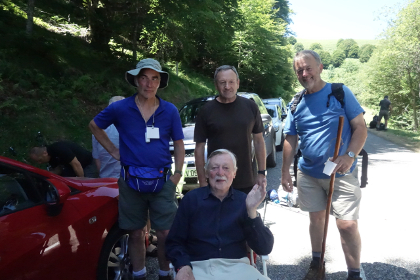 Scott and Judy Goodall, in their time honoured way, kept nerves at bay and spirits high upon our arrival in St. Girons. A blissful Thursday morning bade us ‘Bon Courage’, offering the best possible start to the walkers. That afternoon and Friday saw the temperatures escalate, adding to the challenge of the young, the old, the brave and the bold assembled. Not surprisingly however, the hospitality was as warm as the weather. On the land of the Barreau family, la Mairie of Seix and at Subéra, we were guests of a multinational celebration of friendship, food, drink, singing and dancing – even a birthday or two! Such high spirits a reflection of the memory of the giants in whose footsteps we followed.
Scott and Judy Goodall, in their time honoured way, kept nerves at bay and spirits high upon our arrival in St. Girons. A blissful Thursday morning bade us ‘Bon Courage’, offering the best possible start to the walkers. That afternoon and Friday saw the temperatures escalate, adding to the challenge of the young, the old, the brave and the bold assembled. Not surprisingly however, the hospitality was as warm as the weather. On the land of the Barreau family, la Mairie of Seix and at Subéra, we were guests of a multinational celebration of friendship, food, drink, singing and dancing – even a birthday or two! Such high spirits a reflection of the memory of the giants in whose footsteps we followed.
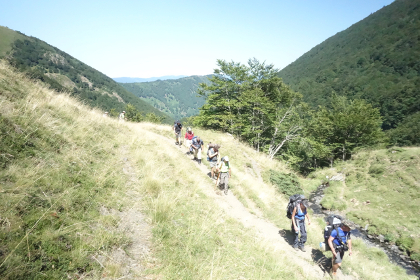 The climb to Halifax on Saturday – the first in three years – was bathed in mist and cloud, adding to the solemnity of the occasion. The cloud slowly cleared for the morning ceremony, as our thoughts were with the souls of the seven young men who lost their lives so long ago. A long, hot afternoon awaited us, casting a burdensome toll on the intrepid walkers, with the climate compounding the physical exertion felt by all.
The climb to Halifax on Saturday – the first in three years – was bathed in mist and cloud, adding to the solemnity of the occasion. The cloud slowly cleared for the morning ceremony, as our thoughts were with the souls of the seven young men who lost their lives so long ago. A long, hot afternoon awaited us, casting a burdensome toll on the intrepid walkers, with the climate compounding the physical exertion felt by all. 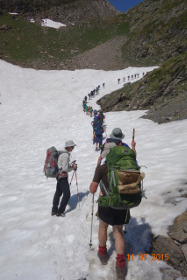 Sunday morning saw a determined start, with a slow and steady passing by the vast majority over the border into Spain. This year’s Chemin gifted the walkers the bittersweet privilege of scattering the ashes of Dot Collins, wife of the late Maurice Collins, who were both dedicated supporters of Le Chemin de la Liberté since its inauguration, following Maurice’s successful crossing during the war. Having never forgotten the courage and sacrifice of those who assisted him, Maurice’s own ashes were scattered at the border in 2006. A poignant ceremony saw the wind gently carry Dot’s remains to join those of Maurice, and the memory of so many more.
Sunday morning saw a determined start, with a slow and steady passing by the vast majority over the border into Spain. This year’s Chemin gifted the walkers the bittersweet privilege of scattering the ashes of Dot Collins, wife of the late Maurice Collins, who were both dedicated supporters of Le Chemin de la Liberté since its inauguration, following Maurice’s successful crossing during the war. Having never forgotten the courage and sacrifice of those who assisted him, Maurice’s own ashes were scattered at the border in 2006. A poignant ceremony saw the wind gently carry Dot’s remains to join those of Maurice, and the memory of so many more.
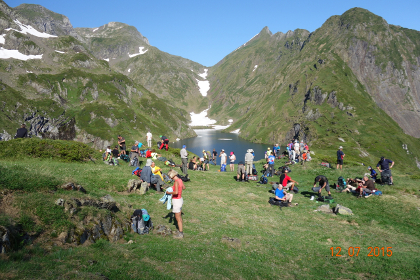 Paul Debon and his team of encadrements led us to Esterri d’Aneu, which greeted us with cold showers and cold beer – both warmly welcome! – as we were serenaded and heralded through the streets. A fine feed, glorious singing of traditional songs and impressive attempts at local dancing (considering the exertions!) saw us ready for the long bus journey to St. Girons. No Chemin is without its challenges, and this year was no exception. Two significant medical events befell this intrepid group, which were handled in a calm, controlled manner notable in the circumstances of the pre-existing exertions, and a credit to those involved. We wish both individuals a speedy recovery.
Paul Debon and his team of encadrements led us to Esterri d’Aneu, which greeted us with cold showers and cold beer – both warmly welcome! – as we were serenaded and heralded through the streets. A fine feed, glorious singing of traditional songs and impressive attempts at local dancing (considering the exertions!) saw us ready for the long bus journey to St. Girons. No Chemin is without its challenges, and this year was no exception. Two significant medical events befell this intrepid group, which were handled in a calm, controlled manner notable in the circumstances of the pre-existing exertions, and a credit to those involved. We wish both individuals a speedy recovery.
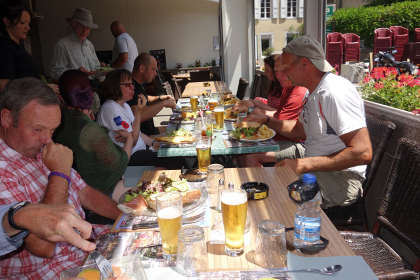 As a blistering sun sets on the twenty second edition, we find ourselves looking forward to 2016. As the years pass, and fewer veterans are present to remind us, we must strive ourselves to remember; to tell of the liberté, égalité and fraternité that has been demonstrated to us in darker times. Far braver people, in far worse conditions, with no kit have done this … at night, in snow, in fear for their lives and in hope of a better future. We will remember them.
As a blistering sun sets on the twenty second edition, we find ourselves looking forward to 2016. As the years pass, and fewer veterans are present to remind us, we must strive ourselves to remember; to tell of the liberté, égalité and fraternité that has been demonstrated to us in darker times. Far braver people, in far worse conditions, with no kit have done this … at night, in snow, in fear for their lives and in hope of a better future. We will remember them.
Fifty Five Years On – The Chemin de la Liberté
Newsletter 6 – 2005
By Sherri Ottis
On the 08 July 1999, with a group of Americans, Belgians, Dutch, English, and French hikers, I left the town of St Girons, and began retracing the escape route over the High Pyrenees Mountains used by escapers and evaders in WWII. Each of the hikers had his or her reason for taking on the hike. Many had fathers or other family members who were evaders. Others took on the trek as a challenge and others, like myself, engaged in this physical torture because they wanted to gain a historians perspective of an act about which they had studied and written.
To everyone who asked why I should do such a thing, I explained that I wanted to know what it was really like to be an evader. I thought that to successfully cross those mountains would give me the answer. I knew my experience would not be the same, after all I had bought hiking boots, had broken them in during long walks, and had been working out in a gym for months to get fit, so unlike the airmen, who had been living in cramped places, had injuries, and had no fitness training. I had good food, had a good pack that I had been walking around with full of weights, and I would not have German patrols searching for me around every bend. This hike would be much easier.
Little did I know that when I left the little bridge in St Girons, how well I would learn my lesson! As the first few hours were more scenic than difficult we all chatted as we walked, having all met up in the first two days. After a couple of hours I could now feel the start of a blister on one heel. I mentioned this to a new Dutch friend who offered tape which I gladly used. The walk continued climbing up quite an arduous winding route up a rocky incline, followed by a steep walk over several years of fallen leaves through a forest, before we stopped for lunch. Two hikers had already decided they would go no further and would finish at the mid-day stop. I now questioned the wisdom of continuing if the rest of the day was to be the same.
At the lunch break another new friend, an Englishman, patched up both my feet for me, and after a rest and lunch, I was ready to continue the route, although still not sure that I should. I did not want to quit. I felt better when I heard that others had dropped out, and others also had sore feet. Dutchman Gert Overeem, and Englishman Roger Stanton now became my guardians. Roger was determined that I should reach Spain and placed me right at the front of the walkers with him, to set the pace. I appreciated the encouragement from both men, although I believed that I was slowing the group down. By now I was growing closer to people in the group, many of whom were also struggling, and did not want to let anyone down. I also reminded myself that evaders had struggled, many of them had badly blistered feet too. By the time we had reached the first night stop my feet were not good. Roger once again patched them up. We all ate well, but I did not sleep well. The next morning I went through my kit with Roger and unloaded all but the bare necessities from my pack. Roger had a backup plan to share my kit amongst his team of British soldiers (who had agreed), that if I ran into further problems with weight they would carry my kit.
The walk started well the next morning, but at the first stop I sought help for my feet. This time my feet became an international affair. While everyone rested, Roger and one of the Belgians taped up my feet and heels so that nothing would come off, and a fellow American Lyn David provided a dry pair of socks to finish the job. We started off again with hardly any pain to my feet. I was however becoming more and more tired as we climbed up to numerous ridges, only to see more ridges ahead, the ground was clearly not going to level out. After a while I stopped looking. My pack did not feel heavy, but when I leaned over on my walking stick for a break, the pack tipped me to the ground! Set back on my feet by Roger and Gert I kept going. I watched Roger’s feet in front of me and focused on keeping in step. Now in between the two men Roger told me to only watch the foreground and plod on slowly. It was at this point that I recalled the story of an evader called Roland Barlow who had said that only by watching the guide’s legs in front of him was he able to continue. When Roland fell to the ground with total exhaustion his guide threatened to shoot him. Roland laughed, he could not move. I mentioned to Roger about a break. No gun was waved at me and we stopped.
Sensing I was now struggling, my footsore Belgian friends offered high protein rations to eat, and I was made to drink more water. These were ‘suggestions’ given in a manner with which I should not argue. Again we started walking and after a short period I again lost my balance, and I noticed that my feet were all right, but that I was losing strength in my legs. The three Belgians behind me took my pack off me and ignored my protests. The pack was shared out to Pascal Herman, Bob Croes, and Alain Ancker, with Bob taking the bulk. Johann released one of his carabiners, hooked my water bottle on to it, and fastened it to my belt. I set off again behind Roger with Gert behind me followed by the Belgians and the British. Each time I got tired they stopped with me until I was able to continue. Fifty five years ago other Americans were struggling, helped by French, and Belgians. Now another American was struggling to make the same trip, once again assisted by Belgians, French, and English.
We finally reached the lunch stop on the second day at the Col de la Core. We had a chat, and Roger and the team offered assistance to the night stop at Subera. It was suggested that I then made a decision whether I wished to continue. From Subera the route would be even more difficult, very steep and dangerous. As I sat on the grass I knew that my hike was over. Many people had already dropped out. I sat teary-eyed with my many helpers, and thanked them all for their assistance. The Col de la Core was the last point a vehicle could get to, to extract me from the walk. Others also left at this stage. When the walkers left we stood miserably on the side of the hill and waved. The last man I saw disappear behind rocks was a Dutchman who waved to me and blew me a kiss.
Later, on meeting the walkers in Spain, I was reminded what I had accomplished. I had probably come closest to experiencing what it was like to be an evader. That may be true. The route was a long, difficult and dangerous route for those who continued. I had experienced the good fortune of the close relationships that developed between evaders and those who helped them. Those who could help and those who could not, and I made bonds with my fellow walkers that led evaders to remain in contact with their helpers many years after the event. I felt the anguish felt by evaders who could not make the walk through injuries or weakness.

It took over two months to recover from trying to cross the route, but I will never regret having tried. I will regret not crossing the French-Spanish border at the mountain summit. I did not sign the blue Visitors Book for the people who had completed the route, but I know that I gave it all I had, and I can honestly say that I experienced what it felt like to be an evader crossing the Pyrenees.
In September of the following year I was invited to the new Comète Freedom Trail event, and again met up with my friends, English, Belgian, Dutch, and French.
This time the event started by parachute in Belgium, and cycled, and I followed the route by train to Anglet. This time I was able to sign the visitor’s book as a walker, made all the more special as I was the only American to walk the new Comète route. Few historians are fortunate enough to be able to touch the history they study. I have been very lucky to have been able to touch it, and to share the emotional, mental, and physical journey taken by evaders and helpers. For this I will always be grateful.
